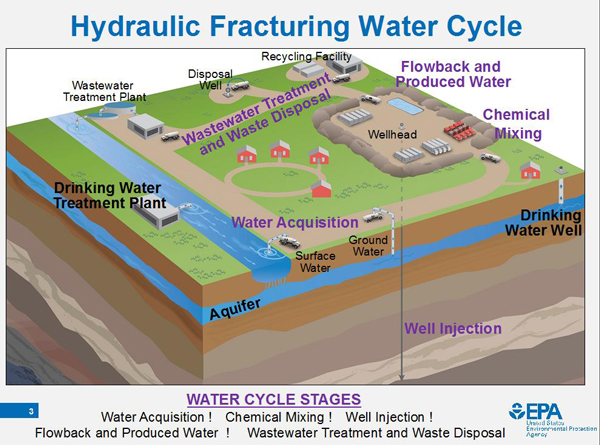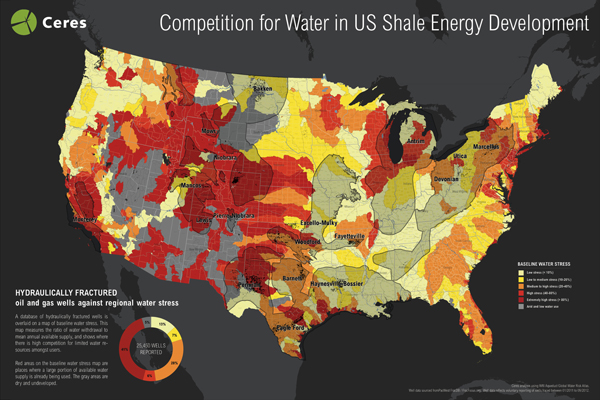Controversy concerning the practice of hydraulic fracturing and unconventional oil and gas development is about more than just breaking up underground rock deposits to release gas and oil. The policy discussion is also about the overall risks and benefits of the entire industrial process of development, from exploration and drilling to build-out of infrastructure, land use changes, production, transportation, and the cumulative impacts on communities of the business of extracting fossil fuels from shale deposits. The injection of water, sand, and chemicals deep below ground is clearly part of issue, but so is the fact that drilling is occurring in dense patterns across the landscape in many regions unaccustomed to energy development.
 One of a series of posts discussing critical questions highlighted in the Fracking Informational Toolkit, a resource for active citizens in communities facing decisions on fracking.
One of a series of posts discussing critical questions highlighted in the Fracking Informational Toolkit, a resource for active citizens in communities facing decisions on fracking.
For some, these unconventional oil and gas resources are the key to the economic future of the country and the only thing to consider is benefits—and they seem to imply that no environmental, health, or socioeconomic costs need be considered or even mentioned. For others, there is a long list of concerns that need to be addressed now, not at some unspecified, nor guaranteed future date. To help frame those questions, and guide people to resources that can help in the search for better information, the Center for Science and Democracy at UCS produced a community guide to questions about fracking.
Among the risks, water ranks high
Our recent forum on “Science, Democracy, and Community Decisions on Fracking” had people with many points of view across this spectrum in the room. It was clear that there are many unanswered questions that citizens and community leaders have concerning the impacts of fracking. When we talked about risks, it was in the broader context of unconventional oil and gas development—including all of the associated complex supply chains, water lifecycles, supporting infrastructure and community impacts.
Of all of the issues raised in our forum, the press, and online, potential impacts on water seems to rise to the top. Are there impacts on drinking water? Where will the water come from and will that affect other uses? What happens to the fracking fluid that is injected, and the wastewater that comes back up? What about spills or accidents? Are there plans in place to deal with them? And, ultimately, while all energy development has risks and unconventional energy is obviously no exception, what level of risk to our environment, communities, and health is acceptable? That is a societal, a community choice, not a private-sector decision.
What the evidence says
The scientific evidence to answer these questions is surprisingly hard to come by for many reasons discussed in an upcoming UCS research report (to be available September 29). However, there is scientific evidence that drinking water can be impacted by unconventional oil and gas development, despite statements to the contrary. Improper or faulty well casings, intended to isolate groundwater resources from methane or the chemicals pumped into the shale, as well as those that come back up as “flowback or produced water” from deep underground as wastewater, can result in contamination due to leakage. Of course casings are designed not to leak, but there is a failure rate of at least a few percent (3% failure rate has been documented in one study in Pennsylvania) that needs to be considered.
Furthermore, during operations, spills can occur either from equipment, wastewater storage facilities, trucks or pipes, and there is the potential to contaminate groundwater—as has been documented, controversially of course, in New Mexico, Pennsylvania, and Wyoming. More alarmingly, incidents of illegal disposal of wastewater in public waterways leading to direct harm to livestock and fish have also been reported. Methane seepage into the water supply has also been documented in Pennsylvania and is a crucial challenge that many are working upon.
Hydraulic fracturing often uses a lot of water—3-6 million gallons per well is the most often cited number. In some areas, there is clearly concern about competition for scarce water resources from communities, farmers, or wildlife. A recent Ceres report found that nearly half of shale energy development was occurring in water basins with high or extremely high water stress. The biggest pressures are in Texas, where meteoric fracking growth is straining the state’s limited surface water supplies and already depleted groundwater aquifers.
The industry is scrambling to reduce these pressures by boosting water recycling and use of brackish water rather than fresh water. However, there are limits to recycling options and most water used in fracking operations is not recoverable.
There has also been a lot of focus on the chemical composition of the fluid pumped into the well, and controversy around industry disclosure of those chemicals. Most often the argument has centered on trade secret protections. However, the associated sand mining for use in fracking and on site chemical mixing also pose risks to surface and ground water resources. The chemicals injected down the well also form part of the wastewater that comes back up the well. That waste also includes other materials brought up from depth, often including naturally occurring radioactive material or substances like arsenic. Chemical information on waste water for disposal is even harder to come by. Some states are now revising and evolving their wastewater management requirements to deal with these challenges.
The disposal methods for wastewater vary. For example, in the Northeast, most of it goes to commercial wastewater facilities, others to unspecified “special” facilities, and much of the waste is stored temporarily on site waiting for removal. There has also been an elevated need to carefully contain the drill cuttings sent to landfills due to the high levels of natural occurring radioactive materials that could leach. And in most other regions waste water is re-injected into deep wells that are intended as long term waste disposal sites. Transporting the large volumes of wastewater to these disposal wells can be a burden to local communities through increases in traffic, accidents and damages to local infrastructure.
That raises the larger issue—who is monitoring water supplies near shale oil and gas operations, wastewater disposal, spills and accidents, and the overall impacts on the water supply? The answer seems to be that the monitoring and penalties for non-compliance are inadequate, especially given the revenues from oil and gas development. In fact those penalties that have been levied for water pollution are often quite small.
Assessing risks in context
All energy development poses risks on the environment, but never before has energy development been so widespread and intertwined with our communities and local water supplies. We know that impacts can occur and that there are potential risks to water resources, though the information is far from complete. But there isn’t a comprehensive monitoring program, and fundamental studies and efforts to understand impacts and address the risks are just getting underway. Nor can we effectively assess more comprehensive and cumulative risks to communities without better data on water risks.
While there are still many unknowns regarding the environmental, health, or social impacts, there is clearly enough information to conclude that there are risks accompanying unconventional oil and gas development, and given the potential impacts, more risk management and protective measures should be applied until we collectively know more. Better information is part of risk management—to emphasize the importance of comprehensive monitoring and sharing of information. And the argument that we can’t manage risks until we have all the information just doesn’t hold water, if you will pardon the pun.
We need precautionary measures—prudent foresight—because public health and safety is at stake. This means, at a minimum, strengthening the protections that are needed to ensure accidents are minimized and quickly addressed when they inevitably occur; assuring that first responders have the information they need in emergencies; protecting water supplies; and reducing the conflicts over water. Two key preventative measurements for water should involve requiring more protective setback requirements from water supplies and better wastewater storage requirements and management plans. Ultimately, scientists need access to data to identify risks so that citizens can be empowered with the information they need to make evidence-based decisions about fracking in their communities. And I know we are not there yet.
Note: This post was coauthored by Andrew Rosenberg and Monika Freyman, an expert on water and shale energy issues at Ceres who authored a recent report, Hydraulic Fracturing and Water Stress: Growing Competitive Pressures for Water.


